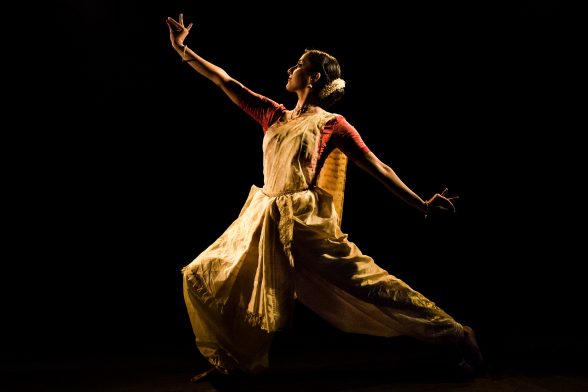
Young, dynamic Mythili Prakash is making waves in the field of Bharata Natyam. Trained by her mother, Bharata Natyam exponent Viji Prakash, Mythili has also had the opportunity to study with several legendary Gurus, including Mahalingam Pillai, Kalyanasundaram Pillai, C.V. Chandrasekhar, Bragha Bessell, and is currently under the tutelage of renowned dance exponent Malavika Sarukkai.
1) What does Swadesh mean to you?
The immediate answer seems straightforward: India. But almost just as immediately, the word invokes multiple resonances. I was not born in the India, nor I have I lived most of my life in the country. Yet, what is it that creates in me this deep sense of identity and belonging to the country? What is it that drives me to define Swadesh as India? This is a question I tackle often, as people ask me constantly “What is it about being in India that you love so much enough to leave your “home” to be here/there?” There are the obvious answers: The art, the culture, the throbbing pulse, the warmth, the colour, the food, the sounds,… (not so much the smells!) But more than that, it’s the feeling that underlies these answers. The feeling of a collective whole – of a belonging to a much larger process- that permeates and characterises the country. India is a country driven by the heart, anchored by belief, hope, and trust in a higher power. For me, it is inevitable to contrast the East with the West, the “desh” in which I have been born and raised. While the West is more about individuality, the East is more about the collective whole. Whereas the West relies more on intellect, reason, and analysis, the East relies more on intuition, feeling, and faith. On this faith is what, I believe, rests this country. I see this “faith” as both incredibly beautiful, and incredibly destructive. To me, this seeming contradiction is what also most distinctly characterises “Swadesh.”
The country is a spiritual spring of Masters of “Advaita” (Oneness), and Yoga, the methodical and mystical practice in pursuit of this experience. Yet, this treasure remains, to a large extent, masked by the externalities of ritual and religious practice. The experience of Oneness has been fragmented into seemingly contradictory beliefs and practices that have become that primary reason for mass violence and bloodshed.
As an individual who grew up around these religious customs, but has always been drawn towards the more mystical aspects, I always found the contradiction confusing and frustrating. “How can one say, “ ‘God’ is in everything, and then worship with full conviction a stone idol or photo?” If one has implicit faith in a Supreme power, why the imposition of expectations – “Dear God, I am paying _______ and buying _____ lbs of brown sugar, and ________ coconuts. Please give my daughter a baby son.” Doesn’t implicit faith mean sheer acceptance of outcomes? Why do symbolism and metaphor overshadow the very thing that they symbolise?
2) What part of the process of creating Swadesh has been the most interesting or enjoyable to you? Or the most challenging?
For me, working through this contradiction artistically has been the most interesting, enjoyable, and challenging. What began as an interrogation of “contradiction” became a process of self-interrogation, resulting in an heightened empathy, understanding, and appreciation of “co-existence”. To me, the treasure of Swadesh is in its spiritual core which transcends its very own boundaries, yes, but its radiance is experienced through the sensual. Is not dance, music, and all expression of art a delightful outcome of this sensual experience? Swadesh is at once, both this and that. Outer and inner. Manifest and the concealed. The worshipper, the act of worshipping, and the worshipped.
3) What do you think audiences can expect or look forward to in Swadesh? What do you hope they’ll take away with them? What will they experience?
As an artist, I always find this an incredibly difficult question to tackle. When working on the inside, its almost impossible to step out until the piece has been birthed on stage. I think what is special about this production – for all of us, has been a process of discovery, which continues. Swadesh is definitely not a concept that is black and white. The word itself has many resonances. What the audience will see in each of our pieces is a very personal journey, that speaks of our sentiments and driving beliefs at this stage in our artistic and personal lives. The piece that we create today would perhaps be completely different from one that we would have a created some years ago or one that we would create in future years. But one thing is for sure, the power of Swadesh in its cultural, artistic, and spiritual splendor is sure to shine forth!
See Swadesh in Liverpool at The Capstone Theatre on Friday 7th March and in London at Bharatiya Vidya Bhavan on March 8th.
Read Production Diary 1, Production Diary 2, Production Diary 3 and Production Diary 4 for further insight into the production, and take a look at Swadesh In Pictures to get a feel for the final production.
This entry was posted in Archive, Dance Events, Dance News, Events Based, News Based. Bookmark the permalink. ← Swadesh – Production Diary 4 Swadesh Dancer Profile – Monisa Nayak →